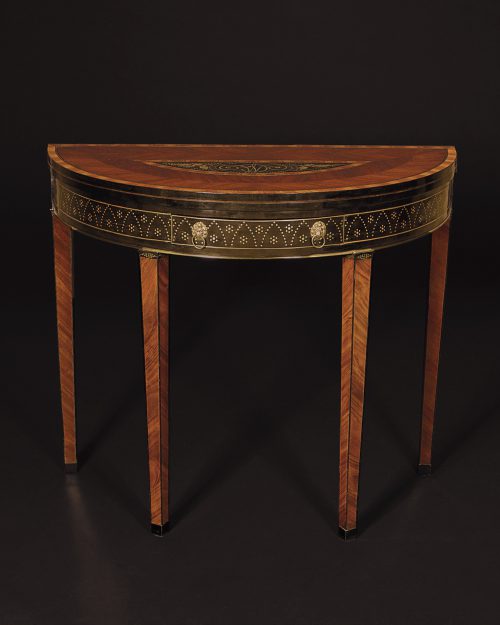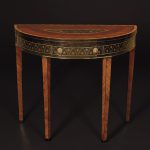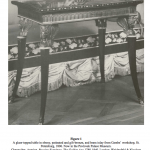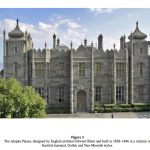9813 A PAIR OF BRASS-INLAID DEMI-LUNE CARD TABLES ATTRIBUTED TO HEINRICH GAMBS BEARING THE MONOGRAM “W.D.” PROBABLY SIGNIFYING THE WORONZOFF-DASHKOFF FAMILY Russian. Early 19th Century. Measurements: Height: 24 1/2″ (74.75 cm) Width / Diameter when open: 34 1/2″ (87.75 cm) Depth 17 1/4″ (43.75 cm)

Research
Of mahogany(?), ebony and tulipwood, with gilt-brass mounts and inlay. Each table with hinged top with cross-banded border surrounding concentric cross-banded sections, centered by an ebony D-shaped section inlaid with gilt-brass leaf decoration within borders of gilt-brass dot inlays and surrounding a circle of further gilt-brass dot inlays which contains the monogram WD. Opening to reveal a polished quarter-veneered interior surface. The ebony frieze with two inlaid gilt-brass bands surrounding a repeating design of gothic arches and rosettes of gilt-brass dot inlays, centered by a drawer with two ringed lion-mask pulls. The whole raised on four tapering legs, each topped with ebony veneer inlaid with gilt-brass dot inlays in a diamond pattern and terminating in a square ebony veneered foot.
Provenance:
Sold by H. C. Baxter and Sons at the Grosvenor House Antiques Fair, 1992
The David Roche Collection, Australia
Published:
Menz, Christopher, and Robert Reason. Empires & Splendour: The David Roche Collection. Adelaide: Art Gallery of South Australia, 2008. 156.
Under the patronage of Catherine the Great (1729-1796), the Scottish architect Charles Cameron (1745-1812) was responsible for introducing furniture designs to Russia that were often variants on the English models developed by his contemporary Robert Adam (1728-1792). The present tables are in a demi-lune form typical of English gate-leg-action card or tea tables, but are decidedly Russian in their use of contrasting ebony and brass-inlaid decoration on a wood of a rich dark color. The St. Petersburg-based cabinetmaker whose keynote was this type of inlaid work is Heinrich Gambs (1765-1831).
Gambs was born in Würtemberg, Germany, and began his career under David Roentgen. In the late 1780s he emigrated to Russia, where he established a workshop in St. Petersburg that was flourishing by the late 1790s. He sought out the country’s elite clientele, which included Grand Duchess Maria Feodorovna, who commissioned a desk in 1793. He produced many pieces for Pavlovsk Palace, and in 1795 Catherine the Great accepted his proposal for the furnishing of Grand Duke Alexander’s apartments. Not long afterward, in 1801, Gambs was appointed court cabinet-maker and was “principally employed in supplying the Imperial residences, including Pavlovsk, Tsarsköe Selo and the Winter Palace.”1 He is not believed to have signed any of his works, and therefore ascriptions are based on uniform, recurring use of materials and decorative motifs, and the consistent use of mahogany for drawer linings.
Decoration with geometric brass ornament on a black background is a characteristic found in Gambs’ mahogany furniture2 and the repeating Gothic arch seen on the present tables is a staple decorative motif in his body of work. A repeating arch design in brass inlay can be found on a table by Gambs, now in the Pavlovsk Palace Museum, near St. Petersburg (figure 1).
A second related table attributed to Gambs, previously in the collection of Antoine Chenevière Fine Arts, can be seen in figure 2. This table also employs cross-banding on the surface and a frieze of ebony veneer highlighted by brass geometric inlay. Another recurrent characteristic, seen here and on the present pair of tables, are lion masks holding a ring.
The use of small gilt-brass “dots” as a decorative element on furniture, employed here to create a variety of shapes, such as Gothic arches and abstracted flowerheads, is highly unusual, and is found only on one other piece known to us, a center table by Gambs, circa 1800, in Schloss Peterhof, St. Petersburg.3 The elaborate inlaid monogram on the surface of the present tables, framed by an oval shape also executed in these distinctive dots, signals the commission of an important patron. The ‘WD’ initially posed a puzzle, as the Cyrillic alphabet does not contain the letter ‘W.’ However, it is now believed that the patron was a member of the eminent Woronzoff-Dashkoff family of Russia. The surviving heir to the family name, Prof. Alexander Woronzoff-Dashkof of Smith College, Massachusetts, explained to us that: “The tables…quite possibly belonged to my family, since in the nineteenth century the initials would have been W.D. Most often, the name was written Woronzow-Daschkow…the youngest branch of the Vorontsov family was authorized to add the Dashkoff surname in 1807.” It is interesting to note that this year is consistent with the likely construction date of the tables.
The Woronzoff-Dashkoff family were inveterate Anglophiles and employed many English architects, painters and even servants. In 1789 Count Simon Woronzoff was appointed Russian Ambassador to London, where he remained for the rest of his life. His children were undoubtedly influenced by their English upbringing. The Count’s daughter, Catherine, married George Augustus Herbert, 11th Earl of Pembroke in 1808 and the couple resided at Wilton House, Wiltshire, which was remodeled in the first decade of the 19th century by James Wyatt in the Gothic style.
Members of the family played highly important roles throughout Russian history from the fifteenth to the seventeenth century as military commanders, courtiers, boyars, and officers in the Tsar’s household. In the eighteenth century, under Empress Elizabeth, they reached the height of their power, serving in various political positions, including that of member of the Senate, Imperial Chancellors, high-ranking diplomats and a prominent general. A possible owner of the tables may have been Princess Yekaterina Romanova Worontsova-Dashkova (1743-1810), who is said to have been one of the closest female friends of Empress Catherine the Great, having played a leading role in the coup d’etat of 1762, by which Catherine was raised to the throne. The princess was later appointed Director of the St. Petersburg Academy of Arts and Sciences.
Among the family’s multiple estates and houses in Russia, the most notable is Alupka Palace, Ukraine (figure 3), commissioned by Count Simon’s son, Count Mikhail Semyonovich Woronzoff, after his return to Russia. Alupka was designed by Englishman Edward Blore (1787–1879), a recognized establishment architect, and is an extravagant mixture of Scottish baronial, Gothic and Neo-Moorish styles built in 1828–1846. Blore was involved in many projects related to the British Empire, including the completion of Buckingham Palace, and was elected Fellow of the Royal Society in 1841.
The blend of English demi-lune form with rear gate-leg action of the present tables, combined with Gothic arched inlay and the Russian decorative vocabulary of Heinrich Gambs, would have been very much in keeping with the international and eclectic tastes of this family.
The tables are illustrated in Empires & Splendour: The David Roche Collection, by Christopher Menz and Robert Reason, published in 2008.4
Footnotes:
1. Important French and Continental Furniture. Christie’s New York, 18 October 2002, Lot 610.
2. Antoine Chenevière, Russian Furniture, The Golden Age 1780-1840, (London: Weidenfeld & Nicolson Ltd, 1988) 174, Plate 174.
3. Rosemarie Stratmann-Döhler and Wolfgang Wiese, Möbel für den Fürstenhof, (Sigmaringen: Thorbecke, 1994) 174, No. 95.
4. Christopher Menz and Robert Reason, Empires and Splendour: The David Roche Collection, (Adelaide: The Gallery of South Australia, 2008) 156.






Comments are closed.